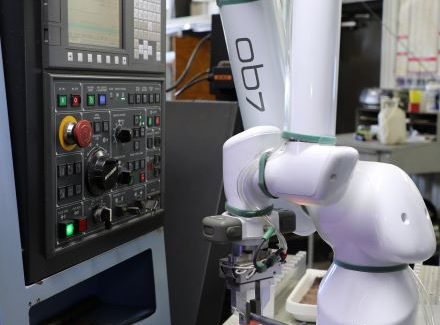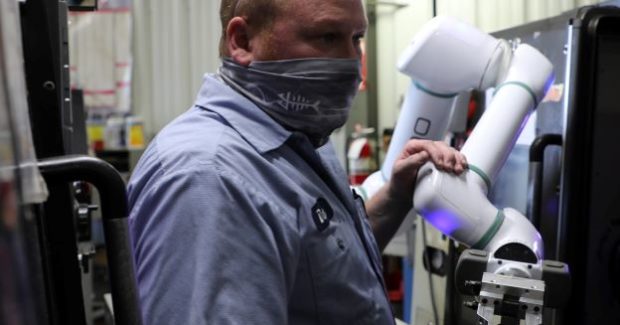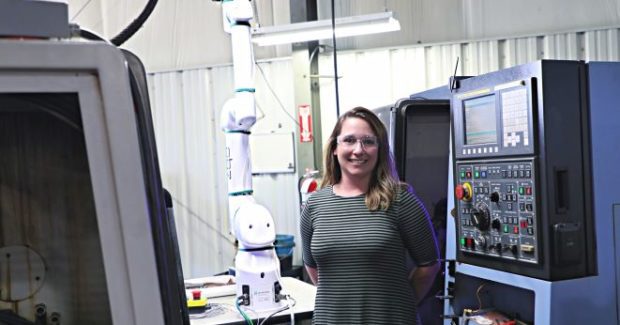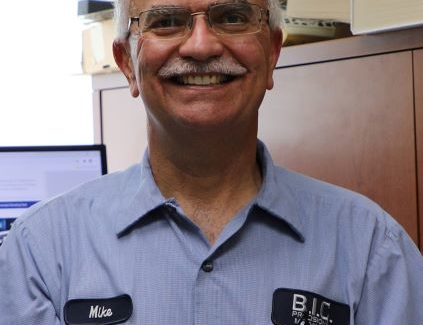Seven-Axis Cobot Brings Worker and Productivity Benefits to B.I.C. Precision
Absolute Machine Tools’ introduction to cobots and its ongoing support to B.I.C. Precision has resulted in many benefits for this job shop, including a productivity increase of at least 20 percent, fewer scrapped parts, faster delivery times and competitive pricing.
Posted: September 29, 2021
Advancing Automation
By Courtney Ortner
B.I.C. Precision is a contract shop in Blanchester, Ohio and a top tier contract supplier of components for essential industries such as food processing and packaging equipment, railroad transportation, oil and gas, electronics and medical. It resides in a 21,000-square-foot factory, with ample surrounding land for future growth. B.I.C. employs nearly 40 people.
In addition to possessing the skills and know-how to produce quality parts, the founding members also infused the company with the family’s faith-inspired values of honesty and compassion for others. That’s one of the prevailing reasons why B.I.C. installed an OB7 collaborative robot servicing a turning center cell. The OB7, manufactured by Productive Robots, is sold and supported in North America by Absolute Machine Tools.
“One of the shaft-like parts we process in our CNC turning center cell requires tens of thousands of parts each year,” said Sarah Burns, business operations manager at B.I.C. “That’s a lot of repetitive motion on a human body. Standing there in a tight space, bending, twisting between the two machines, taking one part in, another part out, doing the finishing details and inspecting. The whole scenario was just too taxing on the body, not to mention the boredom of doing tasks over and over. And, when people are bored, they can make mistakes. Mistakes can lead to accidents and scrapped parts. It’s just human nature; it happens to all of us. We needed a solution.”
After doing research on various options to counteract the human toll, the company chose the OB7 cobot, that they’ve fondly named “Coby.” There were several compelling reasons why B.I.C. chose the OB7, however the top ones were: ease of use; “teaching” (versus programming); all-around flexibility from machine to machine; 7 axes rather than 6 (the OB7 is the only cobot on the market with the 7th axis “wrist” motion); the dedicated and responsive engineering; integration and service support they receive from Absolute Machine Tools; and that it is made in America.
“That was the final seal of approval stamp for us,” Burns said. “We are patriots here, and it means something to us that we are supporting another U.S. manufacturer.”
The application for the OB7 cobot at B.I.C. is loading and unloading parts in the cell. The cell is comprised of two lathes with only 38 inches of space between them. Rather than eliminating the operator’s job, as is often the concern from workers, B.I.C. simply re-allocated the operator’s tasks to loading the parts into the cobot’s pick-up tray and inspecting the parts when they are finished. Burns said this long run of parts requires almost 100 percent inspection of several dimensional features.
“We still need a person in the cell, but he is doing the more interesting, easier-on-the body sorts of tasks and is free to run other machines,” Burns said, “Our workers’ comp claims have reduced significantly. Additionally, Coby never gets bored, so scrap is a lot less now also. We track productivity data, and that’s up at least 20 percent now in the cobot cell. On a long part run, that adds up to a notable profit improvement.
“Our operators who cover that cell are much happier,” Burns continued. “Before installing the cobot our people would work in the cell begrudgingly. Some were very clear about not wanting to work in there at all because of the mundane tasks they had to perform and the cramped workspace that was uncomfortable and could be dangerous. Near the end of the work week, you could see the boredom and fatigue on their faces. But now with Coby as their buddy in there, that mentality has completely changed.”
Burns noted that B.I.C. has been able to maintain workers’ compensation insurance claims at zero for that area, reduce employee complaints, and cut scrap rates by almost half.
Naturally, as with any new technology installed in manufacturing operations, there was the initial operator intimidation with the cobot, however according to Burns, it didn’t take long for a couple of individuals at B.I.C. to become the resident cobot experts. One is a machine operator, Dave Farris, and the other is a college student, Preston Griffin, who is studying engineering and also had some CNC programming knowledge. It’s important to note here that this line of cobots does not require conventional methods of coding or programming. Shop personnel “teach” the cobot tasks by simply using the hand controls on the EoAT (end-of-arm-tooling) and dropping and dragging icons on the touch-screen control tablet. Custom job functions for complex or repetitive tasks can be created, labeled, and saved for future recall. The OB7’s computer controls all axis joints and components, and network ports are locked to prevent unauthorized access.
“Further, to help with the integration we had Absolute Machine by our side every step of the way,” Burns said. “We can’t say enough about their knowledge and support from first introducing us to the concept of a cobot, to its successful implementation, to assisting during the occasions when we need some fine-tuning, to today. It’s on-going. And with regard to our team, once everyone realized that the OB7 wasn’t going to replace any human, that it was almost like a new fellow employee to work with, they relaxed and became more curious about it, wanting to see all it could do.”
One of the things that it could do that no other cobot can is rotate its “wrist” (the J3 arm) with a full, true, 7th axis of motion. The J3 arm joint provides the flexibility to operate in a confined space and reach around obstructions, such as a machine tool’s sliding door. In B.I.C.’s case, the extra axis in the J3 arm allowed them greater flexibility with positioning the two CNC lathes in the cell. It allows the operator to still have access in between the two machines to do maintenance, change inserts and the like.
Machine operator Dave Farris, said, “It’s that 7th axis that made all the difference in giving us greater maneuverability in this cell.”
Tempering any indication that the application itself at B.I.C. was “easy,” all involved agree that theirs was a rather sophisticated setup. The machines are complex to program and require skills to set them up to run in a long production mode. Additionally, the shaft-type parts machined in the cell play a critical role in the transportation industry. They are made of a proprietary stainless-steel material and certain dimensions feature a very tight tolerance, such as the thickness dimension.
“That’s the point that we want to make, that even though, our cell setup was on the more challenging side, installing and implementing the OB7 into this cell was more straight-forward than we expected it to be,” Burns said. “So, for less sophisticated applications that other companies might have, it will be even easier for them.”
With operator safety being one of the main drivers for installing the OB7, B.I.C. also opted for a Safety Laser (Lidar) Scanner to help prevent collisions and that also allows running the cobot at higher speeds. B.I.C. also opted for a larger gripper to better accommodate its wide range of workpieces that are processed in the cell.
To sum up all of the benefits the OB7 has provided B.I.C., Burns said, “There are many, some direct and some indirect. Definitely I would list the operator happiness factor, lower injury claims, greater productivity of at least 20 percent more parts being made, less scrapped parts, improved part quality, faster delivery times, more competitive pricing when we quote on new jobs, and it will likely open doors to new opportunities to quote on jobs that we would not have before. Coby has done so much for us, and Absolute has been such a great partner, that we will not hesitate to add more OB7s in our operations when it makes sense to do so.”




















